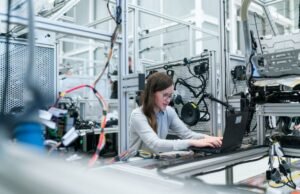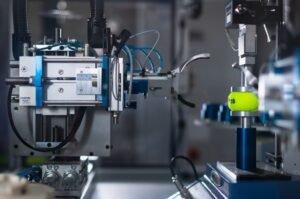Deep Learning with PyTorch – Step-by-Step
PyTorch is a powerful open-source library for deep learning, providing a flexible platform to build and train neural networks. In this article, we will guide you through the basics of deep learning using PyTorch, step-by-step.
Key Takeaways:
- PyTorch is an open-source library for deep learning.
- It provides a flexible platform to build and train neural networks.
- Deep learning involves training neural networks to perform complex tasks.
In the field of artificial intelligence, deep learning has gained immense popularity due to its ability to solve complex problems such as image classification, natural language processing, and speech recognition. PyTorch is a widely used deep learning library that offers a Python-friendly interface and efficient computing capabilities. With PyTorch, you can easily create, train, and deploy neural networks.
Before diving into the world of deep learning, it is essential to grasp the fundamental concepts. Neural networks, the building blocks of deep learning, are designed to mimic the human brain’s structure and functioning. These networks consist of interconnected layers of artificial neurons that process input data and produce output predictions. Training a neural network involves adjusting the weights and biases of the neurons to minimize the difference between the predicted and actual outputs.
PyTorch provides a dynamic computational graph, allowing for more flexibility in network architectures and enhancing the debugging process.
Getting Started
To begin your deep learning journey with PyTorch, follow the steps below:
- Install PyTorch on your system by visiting the official PyTorch website and selecting the appropriate installation instructions for your operating system.
- Import the necessary libraries, including the PyTorch module, to get access to the deep learning functionalities.
- Prepare your dataset by organizing it into appropriate training, validation, and testing sets.
- Create your neural network model. Specify the number of layers, activation functions, and other model parameters according to your specific task.
- Define a loss function that measures the difference between predicted and actual outputs. Common loss functions include mean squared error and cross-entropy loss.
- Select an optimization algorithm, such as Stochastic Gradient Descent (SGD) or Adam, to update the model’s parameters during training.
- Iterate through the training dataset, feeding the input data to the model and adjusting the weights and biases to minimize the loss.
- Evaluate the model’s performance on the validation set to track its progress during training and fine-tune hyperparameters.
- Test the trained model on the test set to assess its accuracy and generalization ability.
Deep learning models can be computationally demanding, requiring powerful hardware or access to GPUs to accelerate the training process.
Key Concepts
Understanding some key concepts in deep learning will help you build more effective models and interpret their results. Here are a few important concepts:
Activation Functions
An activation function introduces non-linearity into the neural network, enabling it to model complex relationships in the data. Popular activation functions include sigmoid, tanh, and ReLU (Rectified Linear Unit).
Loss Functions
Loss functions measure the discrepancy between predicted and actual outputs, serving as a guide for the model to learn and improve. The choice of loss function depends on the nature of the task, such as regression or classification.
Optimization Algorithms
Optimization algorithms determine how the model’s parameters are updated during training. Different algorithms, including SGD, Adam, and RMSprop, have different update rules and convergence properties.
Regularization Techniques
Regularization techniques, such as L1 and L2 regularization, prevent overfitting by adding penalty terms to the loss function or constraining the weights of the neural network.
Interesting Data Points
Let’s take a look at some interesting data points related to deep learning:
| Year | Number of Published Papers on Deep Learning |
|---|---|
| 2010 | 22 |
| 2015 | 2,387 |
| 2020 | 17,288 |
The number of published papers on deep learning has exponentially increased over the years, indicating the rapid growth and interest in this field.
Deep Learning Framework Popularity
Below is a comparison of the popularity of deep learning frameworks:
| Deep Learning Framework | Percentage of GitHub Repositories |
|---|---|
| TensorFlow | 85% |
| PyTorch | 10% |
| Keras | 5% |
TensorFlow currently dominates the deep learning framework market, with PyTorch following at a significant margin.
Start Your Deep Learning Journey with PyTorch
Deep learning using PyTorch offers a powerful platform to explore and solve complex problems. By understanding the key concepts, learning the step-by-step process, and applying practical examples, you can leverage PyTorch to build and deploy your deep learning models effectively.
So, what are you waiting for? Dive into the world of deep learning with PyTorch and unlock the potential of artificial intelligence!

Common Misconceptions
Misconception 1: Deep learning is only for experts in programming
One of the most common misconceptions about deep learning with PyTorch is that it is a complex and intimidating topic suitable only for seasoned programmers. However, this is not true. PyTorch provides a user-friendly interface and comprehensive documentation that makes it accessible to individuals with different levels of programming experience.
- PyTorch offers built-in functions and modules that simplify the process of building and training deep learning models.
- There are numerous tutorials and online resources available that guide beginners through the process of using PyTorch for deep learning.
- Many high-level abstractions and libraries are available in PyTorch that reduce the complexity of implementing deep learning algorithms.
Misconception 2: Deep learning requires a huge amount of labeled data
Another misconception is that deep learning models necessitate an enormous amount of labeled data to be effective. While it is true that deep learning models benefit from large labeled datasets, recent advances in techniques such as transfer learning and data augmentation have made it possible to achieve good performance with smaller datasets.
- Pretrained models are available in PyTorch that have already been trained on large datasets, allowing users to take advantage of their knowledge and expertise.
- Data augmentation techniques, such as image rotation, flipping, and cropping, can generate additional training samples from a limited dataset.
- Transfer learning enables the fine-tuning of pre-trained models on a smaller dataset, leveraging the knowledge gained from training on larger datasets.
Misconception 3: Deep learning is only for image classification tasks
Many people believe that deep learning is only useful for image classification tasks, such as identifying objects in photographs. However, deep learning with PyTorch can be applied to a wide range of domains, including natural language processing, speech recognition, and recommendation systems.
- PyTorch provides libraries and tools specifically designed for natural language processing tasks, such as word embeddings and recurrent neural networks.
- Speech recognition tasks can be tackled using PyTorch’s audio processing capabilities and models such as recurrent neural networks or convolutional neural networks.
- PyTorch’s flexible and customizable architecture allows for the development of deep learning models for various tasks, making it suitable for recommendation systems as well.
Misconception 4: Deep learning models are black boxes with no interpretability
One of the concerns surrounding deep learning is the lack of interpretability in the predictions made by these models. While deep learning models might indeed be more complex than traditional machine learning algorithms, efforts are being made to enhance their interpretability and explainability.
- PyTorch offers tools and techniques for model interpretability, such as feature visualization, saliency maps, and gradient-based attribution methods.
- Methods like LIME (Local Interpretable Model-agnostic Explanations) can be applied to explain the predictions of deep learning models trained with PyTorch.
- There is ongoing research in the field of explainable AI that aims to enhance the interpretability of deep learning models.
Misconception 5: Deep learning always outperforms other machine learning algorithms
While deep learning has achieved groundbreaking results in various domains, it does not always outperform other machine learning algorithms. The performance of deep learning models depends on factors such as the size and quality of the dataset, the complexity of the task, and the availability of computational resources.
- For small datasets or tasks with limited complexity, simpler machine learning algorithms may provide competitive performance with less computational cost.
- Deep learning models often require significant computational resources, such as high-performance GPUs, to train and deploy, which may not be feasible in certain situations.
- The choice between deep learning and other algorithms should be based on a thorough understanding of the problem domain and the available resources.

Introduction to Deep Learning
Before diving into the world of deep learning with PyTorch, it is essential to understand the fundamental concepts behind this powerful technology. Deep learning is a subfield of machine learning that uses artificial neural networks to model and understand complex patterns in data. These neural networks are composed of layers of interconnected nodes, where each node performs a simple mathematical operation on its inputs. Deep learning has revolutionized various fields, including computer vision, natural language processing, and speech recognition, enabling remarkable achievements. The following tables present interesting facts and statistics related to deep learning and PyTorch.
Deep Learning Frameworks Comparison
When getting started with deep learning, it is crucial to select an appropriate framework that suits your needs. Each framework offers its unique set of features and advantages. The table below highlights a comparison between popular deep learning frameworks, including PyTorch, TensorFlow, and Keras.
| Framework | Popularity | Industry Adoption | Community Support |
|---|---|---|---|
| PyTorch | High | Wide | Active |
| TensorFlow | Very High | Wide | Active |
| Keras | Moderate | Wide | Active |
Deep Learning Algorithms Comparison
Deep learning algorithms form the backbone of many groundbreaking applications. Different algorithms exhibit varying strengths and weaknesses, making them suitable for specific use cases. The table below presents a comparison between popular deep learning algorithms, such as Convolutional Neural Networks (CNNs), Recurrent Neural Networks (RNNs), and Generative Adversarial Networks (GANs).
| Algorithm | Application | Architecture | Advantages |
|---|---|---|---|
| CNNs | Computer Vision | Layered | Effective at feature extraction |
| RNNs | Natural Language Processing | Sequential | Handles sequential data well |
| GANs | Image Generation | Generative | Capable of producing realistic images |
PyTorch vs. TensorFlow
PyTorch and TensorFlow are the two leading deep learning frameworks, each with its own set of advantages and use cases. The following table compares various aspects of PyTorch and TensorFlow.
| Aspect | PyTorch | TensorFlow |
|---|---|---|
| Flexibility | High | Moderate |
| Graph Representation | Dynamic | Static |
| Community Support | Active | Very Active |
| Performance | Fast Execution | Scalable |
Deep Learning Applications
Deep learning has found applications across various industries, revolutionizing the way we solve complex problems. The table below illustrates some exciting real-world applications of deep learning.
| Industry | Application |
|---|---|
| Healthcare | Early Detection of Diseases |
| Finance | Stock Market Prediction |
| Automotive | Autonomous Vehicles |
| Retail | Customer Segmentation |
Deep Learning in Research
Researchers around the world are leveraging deep learning techniques to make incredible breakthroughs in various domains. The following table highlights some notable research papers that have pushed the boundaries of deep learning.
| Research Paper | Domain | Key Contribution |
|---|---|---|
| “ImageNet Classification with Deep Convolutional Neural Networks” | Computer Vision | Introduced deep CNN architectures |
| “Attention Is All You Need” | Natural Language Processing | Introduced the Transformer model |
| “Generative Adversarial Networks” | Generative Models | Proposed GANs for realistic image synthesis |
Deep Learning Hardware
Training deep learning models demands substantial computational resources. The table below compares various hardware options for accelerating deep learning tasks.
| Hardware | Pros | Cons |
|---|---|---|
| GPU | Parallel processing, high performance | Expensive, requires additional power |
| TPU | Specialized for deep learning, fast | Limited compatibility, expensive |
| CPU | General-purpose, widely available | Slower than dedicated hardware |
PyTorch Libraries and Tools
PyTorch offers a rich ecosystem of libraries and tools that enhance the deep learning workflow. The following table showcases some popular PyTorch libraries and their functionalities.
| Library/Tool | Description |
|---|---|
| Torchvision | Provides datasets, transforms, and models for computer vision tasks |
| Torchtext | Facilitates text data preprocessing and manipulation |
| PyTorch Lightning | Simplifies the training process with advanced abstractions |
| Ignite | Offers high-level abstractions for building complex models |
Deep Learning Challenges
While deep learning has achieved remarkable success, it still faces various challenges that researchers are actively working on. The following table highlights some significant challenges in the field.
| Challenge | Description |
|---|---|
| Interpretability | Understanding and explaining deep learning decisions |
| Adversarial Attacks | Manipulating inputs to mislead deep learning models |
| Data Privacy | Ensuring sensitive data protection in model training |
Conclusion
Deep learning, powered by frameworks like PyTorch, has transformed the field of artificial intelligence. The tables above provide insights into various aspects of deep learning, from frameworks’ comparisons to real-world applications and challenges. Choosing the right framework and algorithm, leveraging appropriate hardware, and exploring the vast ecosystem of tools and libraries are crucial steps towards successful deep learning projects. As the field continues to evolve, researchers strive to overcome challenges while pushing the boundaries of what deep learning can achieve.
Frequently Asked Questions
What is PyTorch?
PyTorch is an open-source machine learning library that is primarily used for developing and training deep learning models. It provides a flexible and dynamic approach to building neural networks and is widely popular among researchers and practitioners in the field of deep learning.
How does PyTorch differ from other deep learning frameworks?
PyTorch distinguishes itself by its dynamic computational graph, which allows users to modify networks on-the-go during training, enabling more flexibility and ease of experimentation compared to static computational graphs of other frameworks like TensorFlow. PyTorch also offers an intuitive and Pythonic interface, making it easier to debug and understand code.
What is deep learning?
Deep learning is a subset of machine learning that leverages artificial neural networks with multiple layers to learn and extract meaningful representations from large amounts of data. By stacking multiple layers, deep learning models can automatically learn hierarchical features, leading to superior performance in various tasks such as image classification, object detection, and natural language processing.
What are the advantages of using PyTorch for deep learning?
PyTorch provides several advantages for deep learning tasks. Its dynamic computational graph allows for dynamic model creation and modification, making it ideal for research and rapid prototyping. PyTorch also has extensive support for GPU acceleration, enabling efficient training of deep learning models on GPUs. Additionally, PyTorch offers a rich ecosystem of tools and libraries, making it easier to implement complex deep learning architectures.
Is PyTorch easy to learn for beginners?
Yes, PyTorch is considered to be relatively easy to learn for beginners due to its intuitive Pythonic syntax and dynamic nature. Its similarity to Python and NumPy makes it straightforward for individuals with programming experience to grasp the concepts and quickly start building and training deep learning models.
What are the steps involved in deep learning with PyTorch?
The steps involved in deep learning with PyTorch typically include data preprocessing, model creation, training, evaluation, and deployment. Data preprocessing involves cleaning, transforming, and preparing the data. Model creation involves defining the architecture of the neural network using PyTorch’s modular approach. Training includes feeding the input data to the model, computing the loss, and updating the network’s weights through backpropagation. Evaluation entails assessing the model’s performance on separate test data. Deployment involves applying the trained model to make predictions on new unseen data.
Can PyTorch be used for natural language processing tasks?
Yes, PyTorch is well-suited for natural language processing (NLP) tasks. Its dynamic nature and powerful GPU support make it efficient for processing large language models such as recurrent neural networks (RNNs) and transformers. PyTorch also provides pre-built NLP libraries like torchtext and transformers, which simplify common NLP tasks such as text tokenization, embedding, and sequence classification.
Does PyTorch support distributed training?
Yes, PyTorch has native support for distributed training. It provides the torch.nn.DataParallel module for easy data parallelism, allowing users to leverage multiple GPUs for training. PyTorch also supports distributed training across multiple machines using technologies like the torch.distributed package and frameworks like PyTorch Lightning or Horovod.
Can PyTorch models be deployed on mobile or edge devices?
Yes, PyTorch models can be deployed on mobile or edge devices. PyTorch provides mobile-friendly tools like TorchServe and TorchScript, which facilitate model conversion and optimization for deployment on platforms such as iOS, Android, and edge devices. Additionally, PyTorch Mobile enables efficient inference on resource-constrained devices by leveraging hardware accelerators like Neural Processing Units (NPUs).
Is PyTorch used more for research or production purposes?
PyTorch is widely used for both research and production purposes. Its dynamic nature and focus on flexibility make it popular in research settings, allowing researchers to easily experiment with different ideas and model architectures. However, PyTorch also offers production-ready features for deployment, such as model optimization, serving, and deployment frameworks like TorchServe. Many organizations use PyTorch for large-scale production systems as well.




